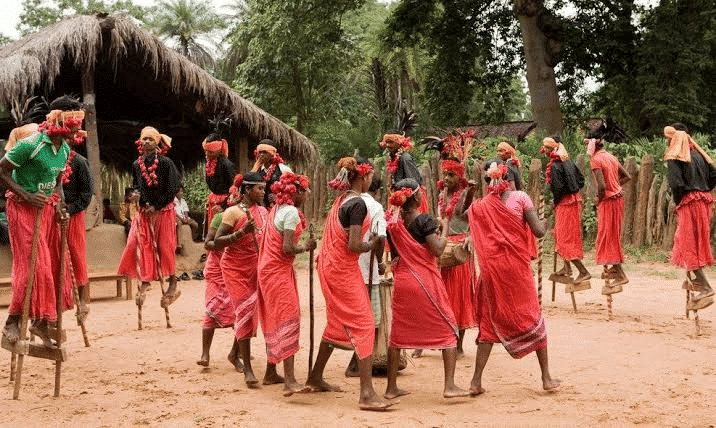Tribal Societies in India | Anthropology Optional for UPSC PDF Download
According to the Imperial Gazetteer of India, a tribe is defined as a collection of families sharing a common name, language, and territory, and claiming common heritage. India, often referred to as a melting pot of tribes and races, has the second-largest concentration of tribal populations in the world, following Africa. According to the 2011 Census, tribal communities make up approximately 8.9% of India’s total population.
Nomenclature for Tribals in India
Tribal communities in India are referred to by various terms, each highlighting their distinct identity and status.
Adivasis (Indigenous Population)
- The term Adivasis refers to the indigenous people of India, considered the original inhabitants of the country. Adivasis possess unique cultures, languages, and customs, having lived in various parts of India for centuries.
- They have a deep connection with the ecology and resources of their regions.
Scheduled Tribes (STs)
The term Scheduled Tribes was first introduced in the Constitution of India, under Article 366 (25), which defines them as communities deemed to be Scheduled Tribes. These communities share certain characteristics such as:
- Primitive traits
- Geographical isolation
- Distinct cultural practices
- A preference for limited contact with mainstream society
- Economic backwardness
Particularly Vulnerable Tribal Groups (PVTGs)
PVTGs, identified in 1975 based on recommendations from the Dhebar Commission, are the most marginalized among the tribal communities. Characteristics of PVTGs include:
- Small, homogenous populations
- Physical isolation
- Simple social structures and technologies
- Low literacy levels
- Economic backwardness
- Declining or stagnant population growth
Forest Dwellers
- Forest dwellers live in and around forested areas and rely on the forest for sustenance. The Forest Rights Act (2006) acknowledges the rights of these communities to access forest resources, vital for their livelihoods, habitation, and cultural practices.
Denotified Tribes
- Denotified tribes (DNTs) were formerly labeled "criminal tribes" under the British-era Criminal Tribes Act of 1871. Post-independence, this Act was repealed, but the communities continue to face discrimination and marginalization.
Nomadic and Semi-Nomadic Tribes
- Nomadic and semi-nomadic communities, such as the Banjara, Lambadi, Raika, Rabari, and Gaddi, move seasonally with their herds or engage in small-scale agriculture, seeking resources for their livelihoods.
Differences Between Tribal Communities and Mainstream Society
Tribal communities in India differ from mainstream society in several key aspects:
- Cultural Practices: Tribal communities have distinct cultures, languages, and customs. For example, the Warli tribe in Maharashtra is renowned for its unique Warli paintings, which are created on mud walls during festivals and ceremonies.
- Economic Practices: Tribal people often rely on natural resources for their livelihoods. For instance, the Bonda tribe of Odisha depends on shifting cultivation and hunting for food, primarily relying on forest resources.
- Social Organization: Tribal societies are typically organized around kinship groups rather than a centralized governance system. The Kondh tribe of Odisha, for instance, has a traditional village council known as the Gudi, which makes decisions and resolves conflicts.
- Relationship to Land: Tribal communities have a deep spiritual and cultural connection to their land. The Bhils of Rajasthan, for instance, regard forests, hills, and rivers as sacred places inhabited by their gods.
Contributions of Tribal Communities in India
Tribal communities in India have made valuable contributions to the country in various domains:
- Environmental Conservation: Many tribal communities have long practiced sustainable ways of living in harmony with nature. The Chenchus tribe in Andhra Pradesh, for example, has been instrumental in the conservation of the Nallamala Hills, preserving both the forest and its wildlife.
- Economic Contributions: Tribal communities are engaged in farming, forest-based livelihoods, and handicrafts. The Gond tribe in Madhya Pradesh is known for its skills in metalwork, painting, and sculpture while also practicing shifting cultivation.
- Indigenous Knowledge: Tribal communities possess vast traditional knowledge related to their environment. The Siddi tribe, of African descent, is renowned for beekeeping and honey hunting and has deep knowledge of medicinal plants, which is now being studied by scientists.
- Political Representation: Tribal communities have also contributed to India’s political landscape. Notable political figures include Droupadi Murmu, the President of India, and Jual Oram, a former Union Minister of Tribal Affairs.
|
108 videos|243 docs
|
FAQs on Tribal Societies in India - Anthropology Optional for UPSC
| 1. What is the nomenclature used for tribal communities in India? |  |
| 2. What are the key differences between tribal communities and mainstream society in India? |  |
| 3. How have tribal communities contributed to Indian society? |  |
| 4. What challenges do tribal communities face in contemporary India? |  |
| 5. How does the Indian government support tribal communities? |  |

















